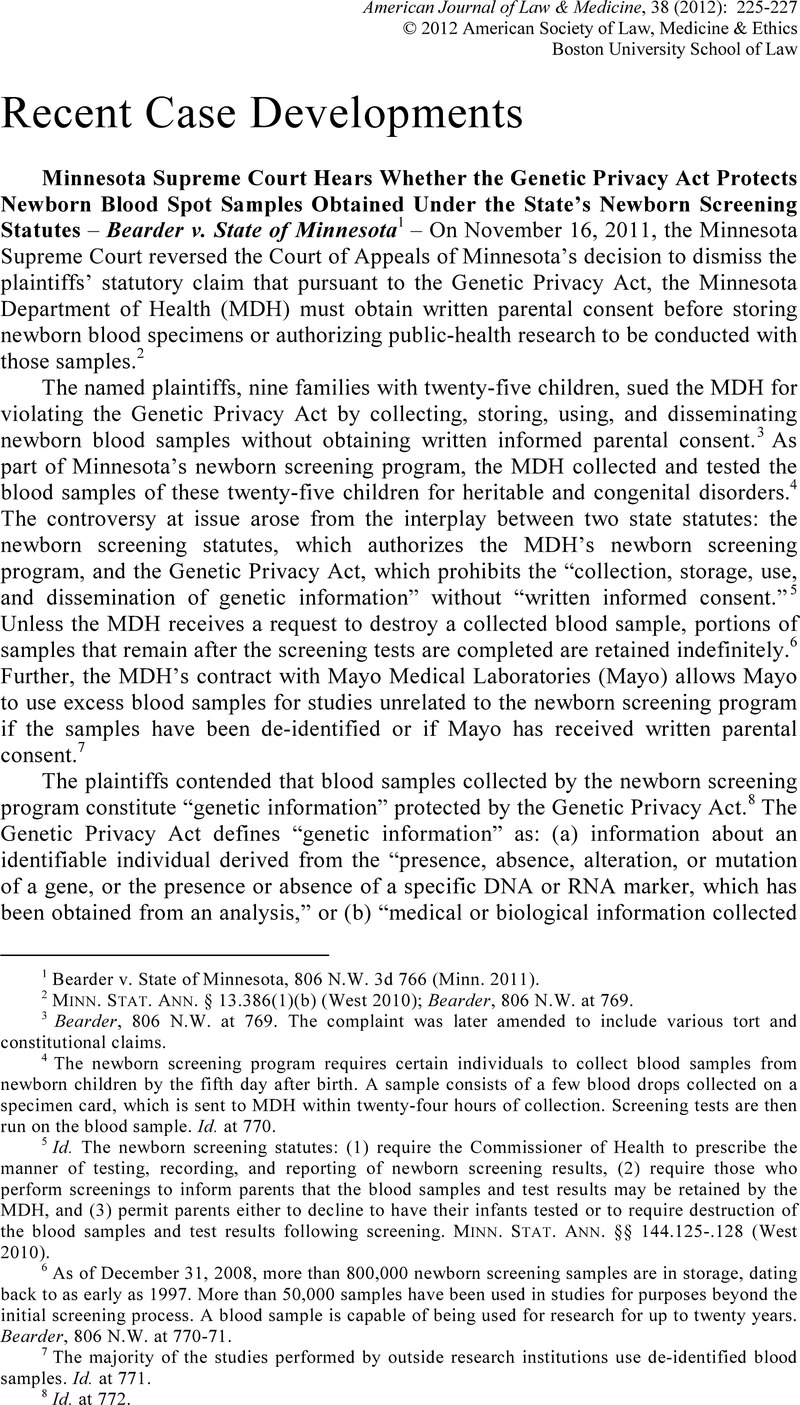Article contents
Recent Case Developments
Published online by Cambridge University Press: 06 January 2021
Abstract

- Type
- Case Report
- Information
- Copyright
- Copyright © American Society of Law, Medicine and Ethics and Boston University 2012
References
1 Bearder v. State of Minnesota, 806 N.W. 3d 766 (Minn. 2011).
2 MINN. STAT. ANN. § 13.386(1)(b) (West 2010); Bearder, 806 N.W. at 769.
3 Bearder, 806 N.W. at 769. The complaint was later amended to include various tort and constitutional claims.
4 The newborn screening program requires certain individuals to collect blood samples from newborn children by the fifth day after birth. A sample consists of a few blood drops collected on a specimen card, which is sent to MDH within twenty-four hours of collection. Screening tests are then run on the blood sample. Id. at 770.
5 Id. The newborn screening statutes: (1) require the Commissioner of Health to prescribe the manner of testing, recording, and reporting of newborn screening results, (2) require those who perform screenings to inform parents that the blood samples and test results may be retained by the MDH, and (3) permit parents either to decline to have their infants tested or to require destruction of the blood samples and test results following screening. MINN. STAT. ANN. §§ 144.125-.128 (West 2010).
6 As of December 31, 2008, more than 800,000 newborn screening samples are in storage, dating back to as early as 1997. More than 50,000 samples have been used in studies for purposes beyond the initial screening process. A blood sample is capable of being used for research for up to twenty years. Bearder, 806 N.W. at 770-71.
7 The majority of the studies performed by outside research institutions use de-identified blood samples. Id. at 771.
8 Id. at 772.
9 Id.
10 Id. at 769.
11 Because the record was insufficient, the case was remanded to determine: (a) whether any party can establish the facts necessary to show that their children's blood samples had been used, stored, or disseminated in violation of the Genetic Privacy Act, and (b) the availability of remedies. Id. at 776-77.
12 MINN. STAT. ANN. § 13.386(1)(b) (West 2010).
13 Bearder, 806 N.W. at 774.
14 Id.
15 Id. at 775.
16 Id. at 776.
17 Id.
18 Some states have specific legislation authorizing the state health department to retain newborn blood samples for research; others do not allow research without parental consent; and many contain ambiguous or conflicting statutory sections governing screening, research, and genetic privacy. Samuel Anderson, From the Cradle to the Lab, GENEWATCH (Jan. 21, 2012), http://www.councilforresponsiblegenetics.org/GeneWatch/GeneWatchPage.aspx?pageId=322&archive=yes.
19 Complaint at 2, Beleno v. Tex. Dep't of State Health Servs., No. SA09CA0188 (W.D. Tex. Mar. 12, 2009).
20 Anderson, supra note 18.
21 Katherine Drabiak-Syed, Newborn Blood Spot Banking: Approaches to Consent—PredictER and Policy Update, IND. U. CENTER FOR BIOETHICS (Mar. 20, 2010), http://bioethics.iu.edu/programs/predicter/legal-updates/newborn-blood-spot-banking/.
22 Id.
23 Without early diagnosis, many of the disorders tested by the newborn screening programs can lead to brain damage, mental retardation, and death. Linda Turner, “Big Brother” and the Growing Controversy Surrounding Newborn Blood Spots, ABA HEALTH ESOURCE (Am. Bar. Assoc. Health Law Section, Chicago, IL), Oct. 8, 2010, available at http://www.americanbar.org/newsletter/publications/aba_health_esource_home/Volume7_02_index.html.
24 Drabiak-Syed, supra note 21.
25 Id.
26 Id.
27 Id.
28 Id.
29 Technological advances have eroded the anonymity of de-identified genetic data. In 2006, the National Human Genome Research Institute removed free access to pooled genomics data that it had posted on the Internet after researchers at Arizona's Translational Genomics Research Institute demonstrated how to detect individual genetic profiles in pools of 1000 or more DNA donors. Anderson, supra note 18.
- 2
- Cited by


